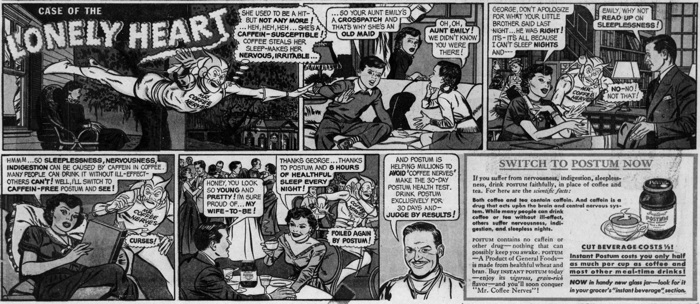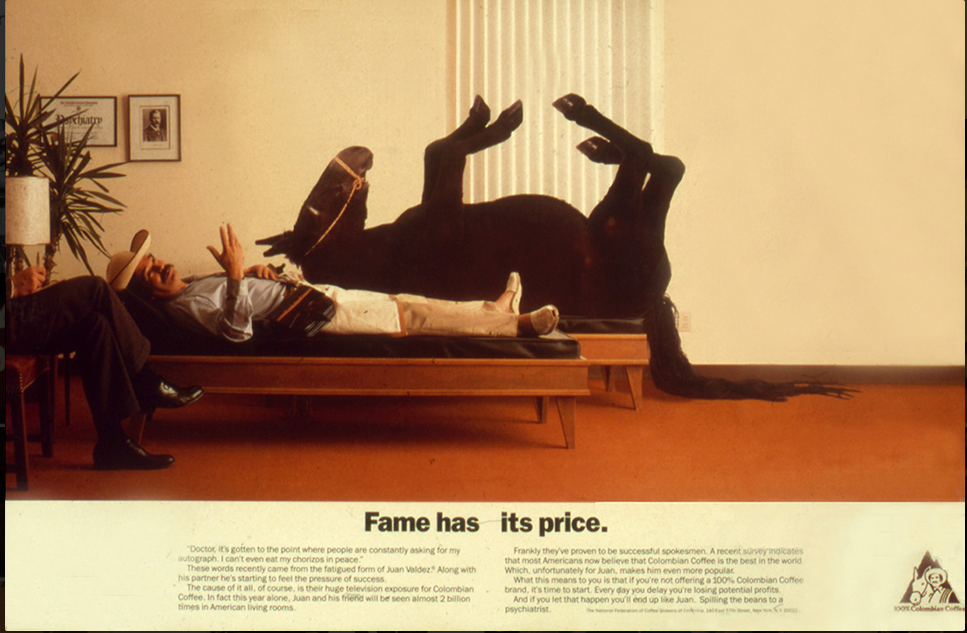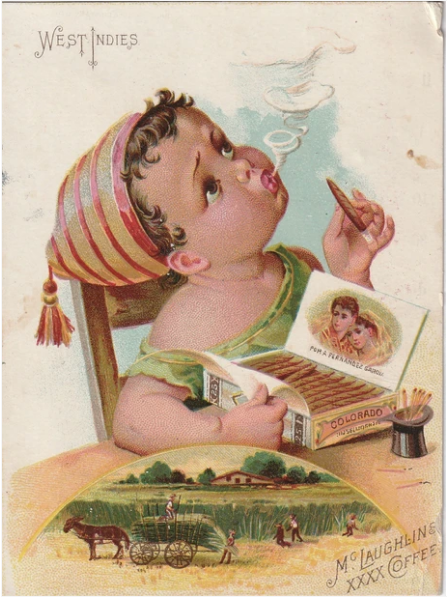Coffee and other Legal Stimulants
Nixon drinks Gevalia coffee
Aug 1971: Posters appeared around Stockholm showing U.S. President Richard Nixon drinking a cup of coffee. They appeared to be ads for Gevalia coffee — though it seemed odd that Nixon would do an ad for Gevalia.
image source: moderna museet
According to Google Translate, "Gevalia dricks mest" means "Gevalia is drunk the most"
It turned out that the posters were the work of artist Kjartan Slettemark. He had combined an image of a hand holding a coffee cup, taken from an actual Gevalia ad, with a photo of Nixon distributed by the U.S. embassy. The posters were apparently a satirical commentary on the recent acquisition of Gevalia by an American company.

Indianapolis Star - Aug 6, 1971
The auction house Bukowskis offers some more details about Slettemark's hoax:
Three years later, Slettemark returned to Nixon as a subject. Slettemark applied for a new passport, but instead of submitting a picture of himself he used an altered picture of Nixon. The passport authorities accepted it. Images and text below from Cabinet magazine (Spring 2009):


Posted By: Alex - Sat Nov 02, 2024 -
Comments (0)
Category: Art, Politics, Coffee and other Legal Stimulants, 1970s
The League of Honest Coffee Lovers
The Pan-American Coffee Bureau was a marketing organization that represented coffee growers from Central and South America. In 1959, it created and promoted the "League of Honest Coffee Lovers." This was a pseudo-grassroots league of Americans rallying to demand stronger coffee.Apparently American coffee had been getting weaker and weaker. In 1950 it was common for restaurants to brew 46 cups from a pound of coffee. By 1959, by adding more water, they were getting 64 cups from a pound. The Pan-American Coffee Bureau wanted to stop this trend.
The League of Honest Coffee Lovers was, itself, just a flash in the pan. But the Pan-American Coffee Bureau had a huge influence on American coffee culture. It's credited with creating the term "coffee break" and getting lots of people to take them. It popularized the year-round drinking of iced coffee. And ultimately it did get Americans drinking stronger coffee.
More info: Lens Coffee

Life - Jan 11, 1960
Those who agreed with the goals of the League of Honest Coffee Lovers could send away and get a certificate of membership.


Posted By: Alex - Sat Sep 28, 2024 -
Comments (4)
Category: Clubs, Fraternities and Other Self-selecting Organizations, Advertising, Coffee and other Legal Stimulants, 1950s
Mr. Coffee Nerves
On a mission to wreck marriages and destroy romance by promoting the consumption of coffee.Personally, I need my morning coffee before I'm at all sociable.
(click images to enlarge)

Spokesman Review - Jan 16, 1949

Boston Globe - Sep 11, 1949
Posted By: Alex - Tue Apr 02, 2024 -
Comments (3)
Category: Corporate Mascots, Icons and Spokesbeings, Coffee and other Legal Stimulants, 1940s
Follies of the Madmen #579

Posted By: Paul - Wed Oct 25, 2023 -
Comments (0)
Category: Animals, Anthropomorphism, Bad Habits, Neuroses and Psychoses, Advertising, Coffee and other Legal Stimulants, 1980s
Gus Comstock, Champion Coffee Drinker
Gus Comstock of Minnesota set a record back in 1927 by drinking 85 cups of coffee in 7 hours and 15 minutes.
Bridgewater Courier-News - Jan 18, 1927
Others subsequently claimed to have beaten his record. Albert Baker of San Francisco claimed to have drunk 157 cups of coffee in 6 hours 20 minutes. However, Comstock complained that there was nothing official about his challenger's claims. They just said they had beaten his record. And Comstock ended up being the most well-remembered champion coffee drinker. Stumbeano's Coffee Roasters (located in Comstock's home town of Fergus Falls) now sells a "Gus Comstock Blend" of coffee.

source: stumbeanos.com
I haven't been able to find any more recent coffee-drinking records. Probably because drinking that much coffee has to be potentially lethal.
Back in my twenties I used to regularly drink 3 or 4 cups a day. Nowadays I limit myself to one cup in the morning.
More info: clickamericana.com

Washington Evening Star - Jan 14, 1927
Posted By: Alex - Tue Jan 03, 2023 -
Comments (6)
Category: World Records, Coffee and other Legal Stimulants, 1920s
Happy Halloween 2022!
Posted By: Paul - Mon Oct 31, 2022 -
Comments (0)
Category: Holidays, Supernatural, Occult, Paranormal, Coffee and other Legal Stimulants
The Coffee Song
An ode to caffeine. Is Starbucks looking for a new theme song?My favorite line is: "You date a girl and find out later/She smells just like a percolator."
Lyrics
Way down among Brazilians
Coffee beans grow by the billions
So they've got to find those extra cups to fill
They've got an awful lot of coffee in Brazil
You can't get cherry soda
'Cause they've got to fill that quota
And the way things are I'll bet they never will
They've got a zillion tons of coffee in Brazil
No tea or tomato juice
You'll see no potato juice
The planters down in Santos all say no no no
The politician's daughter
Was accused of drinking water
And was fined a great big fifty dollar bill
They've got an awful lot of coffee in Brazil
You date a girl and find out later
She smells just like a percolator
Her perfume was made right on the grill
Why they could percolate the ocean in Brazil
And when their ham and eggs need savor
Coffee ketchup gives 'em flavor
Coffee pickles way outsell the dill
Why they put coffee in the coffee in Brazil
So your lead to the local color
Serving coffee with a cruller
Dunking doesn't take a lot of skill
They've got an awful lot of coffee in Brazil
Posted By: Paul - Wed May 04, 2022 -
Comments (4)
Category: Music, Coffee and other Legal Stimulants, 1940s, South America
King Gustav III’s Coffee Experiment
According to what may be legend, King Gustav III of Sweden conducted that country's first clinical trial during the second half of the 18th century. He wanted to determine whether drinking coffee was bad for one's health. He firmly believed it was. The story is told on the website of Sweden's Uppsala University Library:
Barstow Desert Dispatch - Jan 7, 1991
Wikipedia notes that the authenticity of the coffee experiment story has been questioned. Though it doesn't say why.
As far as I can tell, the earliest English-language reference to the story appeared in a 1937 issue of The Science News-Letter. This account was then widely reprinted in newspapers (see below).
The Science News-Letter attributed the information to the Swedish-born botanist Bror Eric Dahlgren, who was a curator at the Field Museum in Chicago. Dahlgren did author a 1938 pamphlet about the history of coffee, which you can read online at the Biodiversity Heritage Library, but it doesn't include the story of King Gustav. I can't locate where else Dahlgren might have told the story of the coffee experiment, which makes it impossible to check his references.

The Sheboygan Press - May 28, 1938
Posted By: Alex - Thu Sep 23, 2021 -
Comments (5)
Category: Experiments, Coffee and other Legal Stimulants, Eighteenth Century
Earl Grey Tea Intoxication
As reported in the April 17, 2002 issue of The Lancet:After 3 weeks, they also occurred in the left foot. After 5 weeks, muscle cramps had spread towards the hands and the right calf. Occasionally, he observed fasciculations of the right adductor pollicis and gastrocnemius. Additionally, he noted distal paraesthesias in all limbs, and a feeling of pressure in his eyes, associated with blurred vision, particularly in darkness...
The patient assumed that there was a relation between his symptoms and his tea consumption, and stopped drinking Earl Grey after 5 months, reverting to pure black tea again. Within 1 week, his symptoms had completely disappeared. Symptoms also remained absent if he completely withdrew from tea, which he did in the nature of experiment, for about a week. He found that his symptoms did not recur as long as he consumed no more than 1 L of Earl Grey daily.
When last seen in November, 2001, neurological examination, nerve conduction studies, and electromyography were normal. He was still drinking 2 L of plain black tea daily (his entire fluid intake), and had no complaints.
The moral of his story is that 2 liters of tea a day is apparently fine. But 4 liters is asking for trouble.

via reddit
Posted By: Alex - Mon Jun 21, 2021 -
Comments (3)
Category: Inebriation and Intoxicants, Coffee and other Legal Stimulants
Follies of the Madmen #506
Not sure how a cigar-smoking toddler promotes coffee...
Posted By: Paul - Tue May 04, 2021 -
Comments (2)
Category: Business, Advertising, Tobacco and Smoking, Children, Coffee and other Legal Stimulants, Nineteenth Century

| Who We Are |
|---|
| Alex Boese Alex is the creator and curator of the Museum of Hoaxes. He's also the author of various weird, non-fiction, science-themed books such as Elephants on Acid and Psychedelic Apes. Paul Di Filippo Paul has been paid to put weird ideas into fictional form for over thirty years, in his career as a noted science fiction writer. He has recently begun blogging on many curious topics with three fellow writers at The Inferior 4+1. Contact Us |




